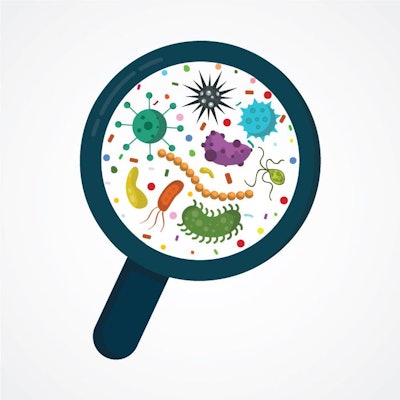
Understanding the gut microbiome across all species has advanced tremendously, including research in the poultry sector.
However, in our excitement about what we are learning about gut bacteria and how we can apply it to improve poultry health and nutrition, we often forget to consider the entire community of gut organisms that are interacting with each other, and how they interact with the chicken itself.
The most populous component of the gut microbiome in poultry is the bacteria, however, two components that are less understood, the mycobiome and the virome, could play just as important of a role in gut health and bird performance as bacteria. As we increase our understanding of poultry gut bacteria, we will, no doubt, begin to view these two additional components as sources for technology advancements in poultry health and nutrition.
Mycobiome
The mycobiome is the name we give to the fungal community present in the overall microbiome.
Generally, the fungal community is much less abundant than the bacterial community, at only 0.001% to 0.1% of the bacteria present.
While our friends in the ruminant world often think about the mycobiome’s role in nutrition, we are just starting to open our eyes to it in the monogastric world. As we do, we are learning that the mycobiome plays an important role in the maintenance of microbial community structure and homeostasis, in a variety of metabolic functions, and in immune system priming.
There is still little research on the poultry gut mycobiome, but we know that the mycobiome is as affected by antibiotics and alternatives as are bacteria, and it may be as important of an indicator for gut health and function. It is worth noting that a key component of the gut mycobiome, Saccharomyces, is frequently used in probiotic and prebiotic formulas and has been demonstrated to improve gut health as an alternative to antibiotics.
Virome
The virome is what we call the community of viruses in the microbiome. While we are familiar with the viruses that impact the host, we can’t forget the vast population of bacteriophages, or viruses, that impact the bacterial and fungal communities.
The virome is a huge source of genetic diversity in the GI tract that is uncharacterized in any animal let alone in the chicken. Research has shown that the virome is important for maintaining microbiome stability and recovery in times of challenge and that it can play roles in immunity and nutrient cycling. Importantly, the virome can also be a source of genetic functions for the bacterial community that it affects, including as a reservoir for genes that convey antibiotic resistance, for example.
While there have been examples of bacteriophage use in poultry, namely for the elimination of salmonella or other food pathogens, we are only scratching the surface in our understanding of the poultry gut virome.
When we think about the poultry gut microbiome we need to think not only about the bacteria present but holistically, including the mycobiome and the virome.
As we learn more about these two areas and how they interact with gut bacteria it is easy to imagine routes for new product development. We could see new fungal based probiotics for poultry that strengthen a positive gut environment, or bacteriophage products that support gut health by working not on the animal but selectively on its bacteria. An approach leveraging all members of the microbiome could offer tremendous potential for innovation and product development, of which I am sure we will be hearing more of in the future.

















